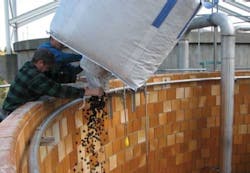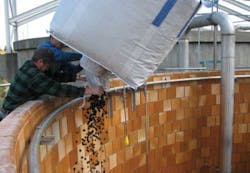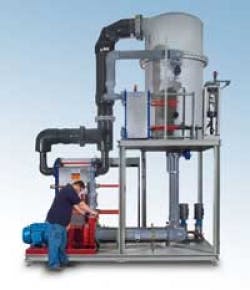Zero Liquid Discharge Installation is the First Permit-Free Chromium Plating Operation
BY DAVID DELASANTA
The profitability of the Columbia Manufacturing Co., Westfield, MA, was significantly affected by the wastewater treatment for its chrome-plating operation and the loss of valuable plating chemicals in the waste stream. The existing treatment process was replaced by a Zero Liquid Discharge (ZLD) system, using vacuum distillation to recover chromium, nickel and water in their effluent. Thanks to this upgrade, Columbia is now the first chromium plating operation in the U.S. that is exempt from air, water and RCRA discharge permits.
Columbia Manufacturing specializes in manufacturing institutional furniture with chrome plated bases made from tubular steel. The plating process required 180,000 gpd of potable water, and produced huge amounts of contaminated effluent containing chromic acid, sulfuric acid, fluoride salts and sulfates from the chromium bath. Dissolved nickel salts from the nickel plating bath were also present, as well as combined ion-exchange regeneration wastes and backwash waters from granular activated carbon (GAC) filters. The waste stream also contained suspended and dissolved oils and greases, used to prevent oxidation of the steel tubing.
Prior to the upgrade, the effluent from the chrome-over-nickel plating operation was treated using standard hydroxide precipitation in a clarifier. Sodium hydroxide, coagulants and flocculants were used to remove metal salts, and the clarified effluent was discharged to the local POTW. A discharge permit was required, setting strict limits on biochemical oxygen demand (BOD), metals and flow. The permit mandated close supervision of the water quality, as did the historic challenges with removal of hexavalent chrome from the final treated effluent. The flocculated metal solids were dewatered using a plate and frame filter press and hauled as F-006 solid waste at considerable expense to the company. The excessive potable water usage, high wastewater treatment costs, permitting fees, and the loss of valuable plating chemistry greatly diminished the company’s profitability.
Columbia sought a treatment solution that would recover chromium and nickel for reuse, and recycle the potable water used in parts rinsing. The company also wanted to reduce the regulatory burden of wastewater permits for the plating line, to minimize the high costs of solid waste hauling and disposal, and to minimize fees for treatment and discharge of wastewater.
Flash Distillation
CASTion Corp. designed and implemented a Controlled Atmosphere Separation Technology (CAST) system to reach these goals. By using vacuum, sensible heat, segregation of waste streams and chemical properties, CAST technology can be designed for a specific process to recover a wide variety of materials, from metals to volatile organic compounds. Treatment can then be augmented by off-the-shelf technologies, including ion-exchange, carbon absorption and reverse osmosis, in order to extract the value in the wastewater.
In a CAST system, the effluent containing dissolved salts (“process solution”) is warmed and sprayed into the low pressure environment of a vacuum chamber, where the water evaporates by the principle of flash distillation. The process solution is drawn into the bottom stage of the vacuum chamber, where it collects (see schematic). This process solution is pumped through a heat exchanger, where it is warmed by hot water or low pressure steam, and is then sprayed downward from a nozzle back into the vacuum chamber. As this heated and pressurized liquid is sprayed into the vacuum, pure water evaporates and rises into the top of the vacuum chamber. A system of baffles captures contaminated liquid droplets, preventing them from rising up with the water vapor, and returns them to the effluent pool. The process solution in the bottom of the vacuum chamber is concentrated by this procedure, so that it can be reused. Alternatively, the dissolved chemicals can be precipitated into solid form and removed from the solution for further processing or disposal.
CASTion Flash Distillation Unit installed at Columbia, demonstrating the vacuum process vessel (top right) with the vapor capture tubes (top left), condenser (bottom left), heat exchanger (center), and circulation pumps (bottom).
It is important to note that during the flash distillation stage, the evaporation occurs within the spray cone and not at the interface of a heated surface, so there is no corrosion or buildup of scale. The clean water vapor rising to the top of the vacuum chamber is condensed into liquid water, and this resulting distillate is often pure enough to be reused or discharged into the sewer. Otherwise, it can be treated further, as necessary.
In a vacuum, the boiling point of liquids is lowered, so the water evaporates at a much lower temperature, typically 100-140°F, and the heat required to generate the vapor is approximately 1040 Btu/LB of vapor. These low temperatures allow CAST systems to be manufactured with engineering plastics and simple technologies, such as hot water heaters, cooling towers and pumps. In contrast, high temperature distillation requires specialty materials and complicated components, such as Freon-based refrigeration systems, or high pressure steam boilers.
Additionally, CAST systems can operate on low temperature heat sources, such as hot water heaters, low pressure steam or waste heat supplies. Operating costs are thus lowered through savings on fuel, and maintenance is reduced through the use of simpler, more reliable technologies.
In the Columbia Manufacturing system, the effluent from the furniture plating process is separated into three streams: the chromium rinse, the nickel rinse and water treatment, each with a dedicated flash vacuum distillation unit. The resulting distillate is pretreated with GAC and oil filtration media and then polished in a duplex ion-exchange system to 1-5 megaohm resistivity. The recovered water is disinfected with UV light to minimize bacterial growth, treated with an ultrafilter to remove organics, and then reused as rinse waters. The two vacuum chamber units dedicated to the plating metals provide recovery for chromium and nickel.
The chrome rinse water is treated in a dedicated CAST 2000 gpd unit, which recovers 650 pounds of chromium trioxide and 10,500 gallons of distillate weekly. The recovered chromium chemistry is cleaned of anionic contaminants by porous pot technology, and then returned to the chromium plating bath.
The nickel rinse water is treated in a dedicated CAST 2000 gpd unit, which recovers 98% of the nickel salts and 14,000 gallons of distillate weekly. The nickel is purified using GAC and then returned to the nickel plating bath.
Process wastewaters consist of 3000 gpd of ion-exchange regeneration wastes commingled with 2,000 gpd of concentrated rinse waters from the front end of the plating line. These are treated in a dedicated CAST 5000 gpd unit, which recovers and returns 4,800 gallons per day of distillate to the ion-exchange system for final polish and reuse in the plating line rinse tanks. The still bottoms from the 5000 gpd system (approximately 200 gallons per day) are delivered to a plate and frame filter press for dewatering.
System Performance
The CASTion ZLD completely eliminated any discharge of wastewater from the plating line, obviating the need for the existing industrial sewer main. Columbia became the first permit-free chromium plating operation in the United States. It is exempted from Massachusetts DEP air and water discharge permits and from RCRA hazardous waste treatment permits.
98% of the chrome and nickel are recovered and reused, instead of being sent to waste treatment as solid RCRA regulated waste. The metal content of the filter cake was reduced drastically, along with the costs of solid waste disposal. The demand for potable water was reduced by 97%, from 180,000 gpd to 6,000 gpd, which is required only to augment losses due to evaporation.
The new system paid for itself within two years. It enabled Columbia Manufacturing to increase its profitability and reduce its environmental impact by recovering chromium and nickel plating chemistries, recycling water, and lowering operating costs and waste disposal expenditures.
About the Author: David Delasanta is Vice President of Sales and Marketing at CASTion. He has 35 years of experience in environmental engineering, construction and the capital equipment industries along with marketing and operational experience including Shaw Group, IT, OHM, Metcalf & Eddy and ICF Kaiser. Delasanta has a BS in Physics, an MA in Engineering and an MBA.


